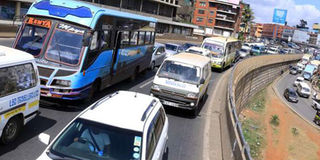We can change city transport for the better

A traffic jam in Nairobi on December 24, 2016. PHOTO | FILE | NATION MEDIA GROUP
What you need to know:
- The governor banned matatus from accessing the Central Business District in a campaign meant to ease congestion.
- Combined with traffic injuries, jams cost low and middle income countries between one and two per cent of their gross national products.
News has been awash in the media about transport challenges facing the City of Nairobi in the preceding weeks.
In the Daily Nation of May 15, 2017, I lauded the government on the prompt decision to form a body dedicated to issues of transport in Nairobi and the surrounding areas, the Nairobi Metropolitan Transport Authority (NMTA).
The expectation was that the body would hit the ground running and position itself to focus on the city’s transport woes. This was not to be as demonstrated by the events of November 12, 2018.
CONGESTION
The governor banned matatus from accessing the Central Business District in a campaign meant to ease congestion.
Traffic jams are a threat to economic development. Combined with traffic injuries, jams cost low and middle income countries between one and two per cent of their gross national products.
However, the pain and anguish felt by travellers as a result of the governor’s action is a demonstration of serious technical capacity deficiency in his backyard, which raises the question whether NMTA is alive.
More than a year after the inauguration of the authority, Kenyans expect at least a roadmap on how the chaos associated with transport in the city are to be tackled.
ACCIDENTS
Sadly, it is missing in action. The authority is expected to embrace emerging technologies to tackle problems of road accidents and traffic jams by applying state-of-the-art technologies embedded in wireless communication technologies such as Intelligent Transportation Systems (ITS) and Internet of Things (IoT).
The US Department of Transport has been at the forefront of technology development based on wireless Dedicated Short Range Communication protocols and implemented as vehicular networks, which has since spread globally.
If appropriately adopted and domesticated by NMTA, vehicular technology as part of ITS can solve most of the traffic problems experienced in Nairobi and other urban centres.
In South Africa, the technology has been domesticated in the Centre for Scientific and Industrial Research and deployed with tremendous success in easing transport in both intra-city and inter-city operations.
SUCCESS
The Rapid Bus Transport in both Johannesburg and Pretoria, integrated with the Gautrain, form a transport network that tells a success story on how technology can guarantee safe and convenient transport in densely populated urban areas.
In Bangok, a metropolitan authority has implemented an integrated urban transport system based on wireless communication technologies that exploits IoT to synchronise operations to guarantee safe and efficient transport involving railway lines (sky trains and subways), rapid transit road systems, public buses, airport express rail links and rickshaws (tuk tuks).
RELEVANT SKILLS
NMTA’s launch must be followed up by relevant appointments for its full potential to be realised. A long standing practice in this country has always viewed such developments as another opportunity to place homeboys without regard to qualification and experience, who end up sleeping on the job.
The appointing authority has not only a responsibility but also a duty to staff the Authority with relevant skills to tackle the problems at hand through deployment of cutting-edge technologies. This will enable it to deliver on the national agenda.
Dr Nyongesa is a lecturer at Masinde Muliro University. [email protected]




